 |
BusTalk
A Community Discussing Buses and Bus Operations Worldwide!
|
| View previous topic :: View next topic |
| Author |
Message |
buron444
Age: 78
Joined: 21 May 2010
Posts: 7
Location: Madrid (Spain)
|
 Posted: Sun May 23, 2010 4:21 am Post subject: Posted: Sun May 23, 2010 4:21 am Post subject: |
 |
|
I think that the specifity of both the Z-403 and the Scenicruiser was being self-supporting, that is chasisless, units. This, in addition to the appealing two.level layout gave them something special.
>>> The PEGASO Z-403 a great example. A bit of a surprise the units had a build of but fifty (50) units. One can try to second guess the minds of the buyers decades back. The bus surely warranted better sales...
The reason behind is that Spain in the early fifties was a non-developped country, still struggling to go out of a very long post-war period (Spain had been excluded from the Marshall Plan).
So, the Z-403 was too much too early (too expensive, too sophisticated) for the then current Spanish circumstances.
The other contemporary Pegaso bus models, much more conventional, the Z-401 and the Z-404, were sold in more than one thousand units along the Z-403 production period.
Pegaso Z-401 intercity coach, body by Seida ( http://en.wikipedia.org/wiki/Seida ):

Pegaso Z-404 city bus, body again by Seida:

One decade later this Pegaso 5022 wore a body that should ring a bell with you:

Do you guess its origin?
José. |
|
| Back to top |
|
 |
Mr. Linsky
BusTalk's Offical Welcoming Committee

Joined: 16 Apr 2007
Posts: 5071
Location: BRENTWOOD, CA. - WOODMERE, N.Y.
|
 Posted: Sun May 23, 2010 1:52 pm Post subject: Posted: Sun May 23, 2010 1:52 pm Post subject: |
 |
|
Jose,
The Pegaso 5022 seems to reflect some American influence in its design and appears to be part school bus and part transit body.
However, I see nothing beyond that that would ring a bell for me.
Clue me in.
Regards,
Mr. 'L' |
|
| Back to top |
|
 |
buron444
Age: 78
Joined: 21 May 2010
Posts: 7
Location: Madrid (Spain)
|
 Posted: Mon May 24, 2010 5:50 am Post subject: Posted: Mon May 24, 2010 5:50 am Post subject: |
 |
|
Well, it is American indeed. Actually it is a Wayne design made in Spain by Carrocerías Bosuga.
I think that you are rather accurate in saying that it appears to be part school bus and part transit body, but am afraid Wayne should perhaps not like this description ... 
This is a 1964 ad:

The second coach is pictured as a Pegaso 5020 CL, the first one as a Barreiros-AEC, time before Barreiros was taken over by Chrysler.
The Bosuga-Wayne venture did not last long, despite having wangled some large customers, like Alsina or Auto-Res. |
|
| Back to top |
|
 |
Steve Carras
Age: 63
Joined: 05 Mar 2010
Posts: 63
|
 Posted: Thu Jun 17, 2010 1:35 am Post subject: Posted: Thu Jun 17, 2010 1:35 am Post subject: |
 |
|
| Mr. Linsky wrote: | 'THE 4502's OF LOS ANGELES MOTOR COACH CO.'
Pictured below in two poses along with an interior shot is fleet number 4208 – a 1940 Yellow Coach Model TD 4502 and one of seventy two delivered to Los Angeles Motor Coach Company in several shipments during that year.
The TD 4502 was the first 35 foot 45 passenger bus of an all aluminum moncoque concept from Yellow in what is now referred to as the ‘Old Look’ design but dubbed by GM as the ‘new model Yellow Transit’ at the time (in 1939 Yellow changed model designations and the previous model 740 of that year became the TD 4501 although it was still of the original integral design).
Simply put, the revolutionary monocoque construction technique, which was much like that of an airplane fuselage, had no longitudinal frame or chassis to carry the weight of the body and its passenger load. Instead, the body itself was the load bearing member assisted by a web of angles and shapes and transverse frame members beneath the floor. Steel was substituted for aluminum only in areas where a tendency to twist might have been encountered.
Lighter weight frameless aluminum construction meant both longer body life and substantial fuel savings which made the Yellow line far ahead of its time and very attractive to operators.
You can learn more about Monocoque construction through the first pages of the July/August 1992 issue of Motor Coach Age.
354 of the 239 inch wheelbase 4502’s were built between 1940 and 1941with the largest number delivered to Pacific Greyhound Lines (123) followed by 72 to LosAngeles, 55 to New York City Omnibus and 37 to Surface Transportation System of New York.
As depicted below, the earliest of the Old Look versions came equipped with vertical windshields which tended to distract drivers by reflecting the bright interior lighting at night. This was improved during the first year of production with the introduction of glass members set at a 24 degree angle – an idea originally specified by St. Louis Public Service so their buses would more closely resemble their PCC cars.
Notice the rare shot of the driver’s compartment in which the austere dash panel is flanked by stainless steel Art Deco wings and the cavernous space found over the driver’s seat where later models would house a Thermo-Matic cabinet.
Los Angeles County has been served by public transit for nearly 130 years. During this time at least 220 companies private and public have operated systems that have included horse cars, cable cars, incline railways, steam trains, electric streetcars, interurban cars, trolley buses, and gas or diesel powered buses.
Various independent bus companies came into being with the intention of competing with the existing system. Most were purchased or subsumed by Pacific Electric or Los Angeles Railway. They include:
• Los Angeles Motor Bus company renamed the Los Angeles Motor Coach Company circa 1930
• LA CBD & Westside Lines 1923-1949
• Motor Transport Company 1922-1939
• Original Stage Line Los Angeles-San Fernando
• Pasadena Ocean Park State Line
• Studio Bus line (Hollywood-Culver City)
• Asbury Rapid Transit System (San Fernando Valley-Hollywood-Pasadena-Los Angeles Central Business District 1930’s-1954)
Photos courtesy of Flickr Services.
Mr. Linsky – Green Bus Lines, Inc., Jamaica, NY
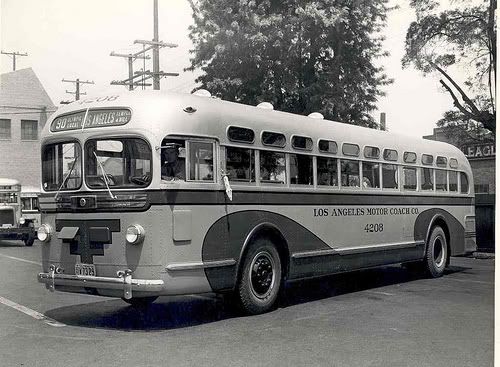
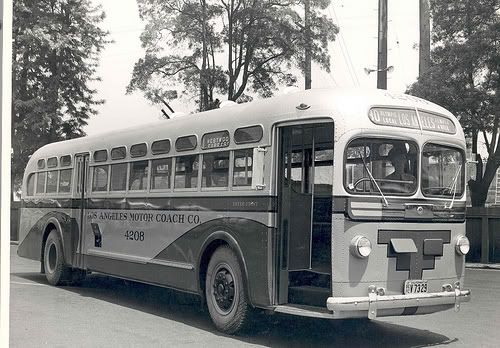
 |
Since it's a TD [Transit Diesel]--I guess it is a stick shift. Then where is the shifter? On the left side? |
|
| Back to top |
|
 |
Mr. Linsky
BusTalk's Offical Welcoming Committee

Joined: 16 Apr 2007
Posts: 5071
Location: BRENTWOOD, CA. - WOODMERE, N.Y.
|
 Posted: Thu Jun 17, 2010 2:33 am Post subject: Posted: Thu Jun 17, 2010 2:33 am Post subject: |
 |
|
Steve,
The first GM buses to add the 'H' to the model came in late 1946 and notably the TDH 4507's.
However, most transit models of the Old Look design starting in 1940 did have hydraulic transmissions and the 'F N R' levers were originally set up on a stanchion to the left of the driver - by 1946 they had been moved to the right side of the dashboard itself (as can just about be seen in the below photo of a Detroit Street Railway 5105).
You'll note in the photo that there's no clutch pedal or stick shift.
Regards,
Mr. 'L'
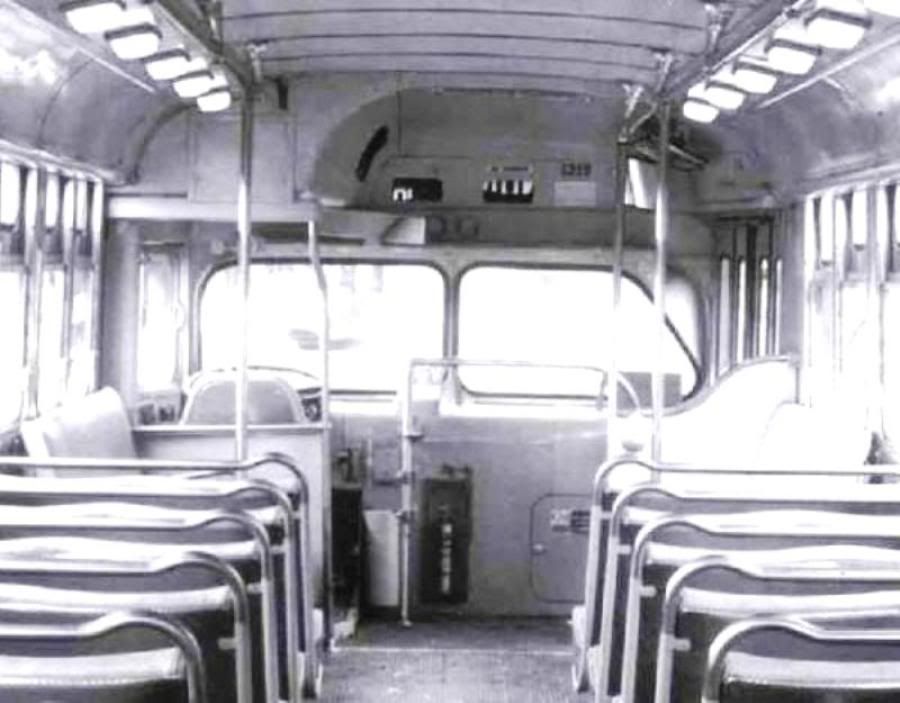 |
|
| Back to top |
|
 |
Mr. Linsky
BusTalk's Offical Welcoming Committee

Joined: 16 Apr 2007
Posts: 5071
Location: BRENTWOOD, CA. - WOODMERE, N.Y.
|
 Posted: Thu Jun 24, 2010 2:46 pm Post subject: Posted: Thu Jun 24, 2010 2:46 pm Post subject: |
 |
|
| Mr. Linsky wrote: | Perhaps the closest thing to a 'jet propelled' bus came in the late fifties with General Motor's experiments in Gas Turbine engines.
This was not a new concept as the company had shown advanced design prototype turbine power plants in both Chevrolet and GMC trucks several years before, but the first bus to be demonstrated with a 'GT300 Whirlfire engine (known as GM Turbo Cruiser I) was culled from a stock TDH 4512 which was later reconverted to original equipment and sold to Detroit Street Railway.
In a second version of a Turbo Cruiser with an improved engine, a stock TDH 5303 with a jazzed up front end (as seen below) toured the country although it was never used in revenue service.
That same 5303 was then updated to a version III and, while its final disposition is not known, it is likely that GM destroyed it as was its habit with most of its experiments.
The system was by no means a failure but operators involved in the study felt that it was too far ahead of its time, too costly and difficult to maintain and unproven.
Original GM photo courtesy of Getty Images.
Mr. Linsky - Green Bus Lines, Inc., Jamaica, NY
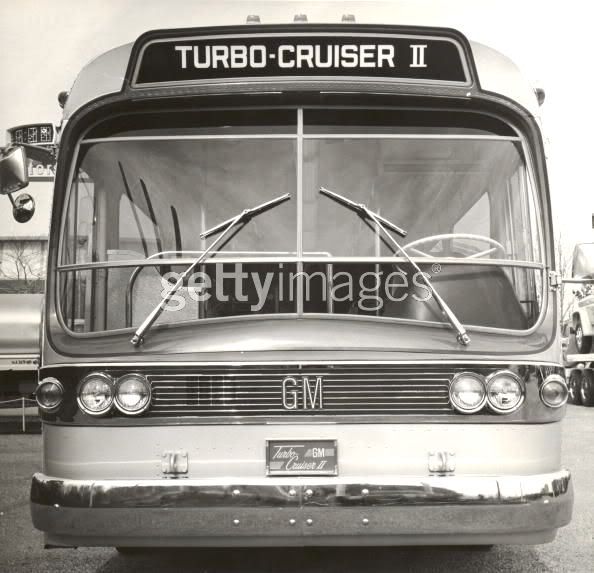 |
I guess I'm quoting myself!
Shown below and on display at the 1964/1965 New York World's Fair 'GM' exhibit is a better shot of the 'Turbo-Cruiser' complete with 'white walls' and 'hub caps'! (I've never seen that on a New Look before!).
Original photo courtesy of GM Photographic.
Mr. Linsky - Green Bus Lines, Inc., Jamaica, New York
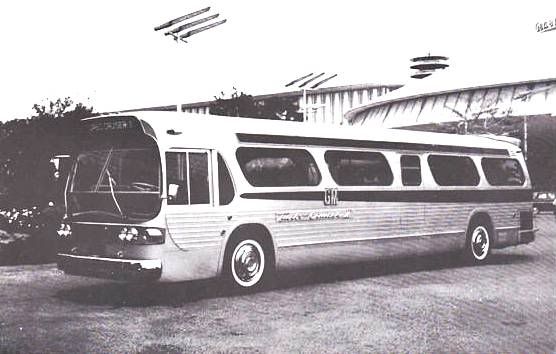 |
|
| Back to top |
|
 |
HwyHaulier
Joined: 16 Dec 2007
Posts: 932
Location: Harford County, MD
|
 Posted: Fri Jun 25, 2010 7:23 am Post subject: Posted: Fri Jun 25, 2010 7:23 am Post subject: |
 |
|
Mr 'L' -
Great photo from the long ago... What G M C would do to make a point about a new product!
Haven't flipped back to look for earlier remarks, but the flirtations with the Garrett Engineering (?), jet turbine technology motors
quickly became a passing fad. A number of the huge fleets provided trials. From what I gather, between pronounced "fuel burn"
rate, and down line, routine upkeep, the charms wore off really fast...
.....................Vern.......................[list=][/list] |
|
| Back to top |
|
 |
Mr. Linsky
BusTalk's Offical Welcoming Committee

Joined: 16 Apr 2007
Posts: 5071
Location: BRENTWOOD, CA. - WOODMERE, N.Y.
|
 Posted: Fri Jun 25, 2010 1:01 pm Post subject: Posted: Fri Jun 25, 2010 1:01 pm Post subject: |
 |
|
Back in the late forties, GM's 'juggernaut' forced Mack to spend large money on advertising in trying to keep at least second place in the transit bus market.
Attached is a typical Mack ad that appeared in Bus Transportation Magazine among other places and featured fleet number 1737 - a 1949 Model C-45-DT and one of over 200 numbered from 1600 to 1810 delivered to Surface Transportation Corporation of New York between 1948 and 1949 (note that, for whatever reason, number 1785 of the group was gasoline powered).
The picture is a rarity because it may be the only chance you'll ever have to see a Surface Mack in one piece!
Mr. Linsky - Green Bus Lines, Inc., Jamaica, New York
 |
|
| Back to top |
|
 |
Mr. Linsky
BusTalk's Offical Welcoming Committee

Joined: 16 Apr 2007
Posts: 5071
Location: BRENTWOOD, CA. - WOODMERE, N.Y.
|
 Posted: Sat Jun 26, 2010 1:33 pm Post subject: Posted: Sat Jun 26, 2010 1:33 pm Post subject: |
 |
|
Here's another interesting ad from 1950 touting GM's Diesel line and its very apparent selling success.
Of note to you New Yorkers, of course, is the lineup of New York City Omnibus Corporation TDH 4509's led by fleet number 2756.
I can't say that GM Photographic performed any magic in this particular image but it was their habit to photograph one or two buses and then super impose those same buses once or twice behind the original two to make it look more like a fleet.
Also note that Miami Beach Railway elected only fresh air roof intakes in lieu of ThermoMatic systems.
Original photo by GM Photographic.
Mr. Linsky - Green Bus Lines, Inc., Jamaica, New York
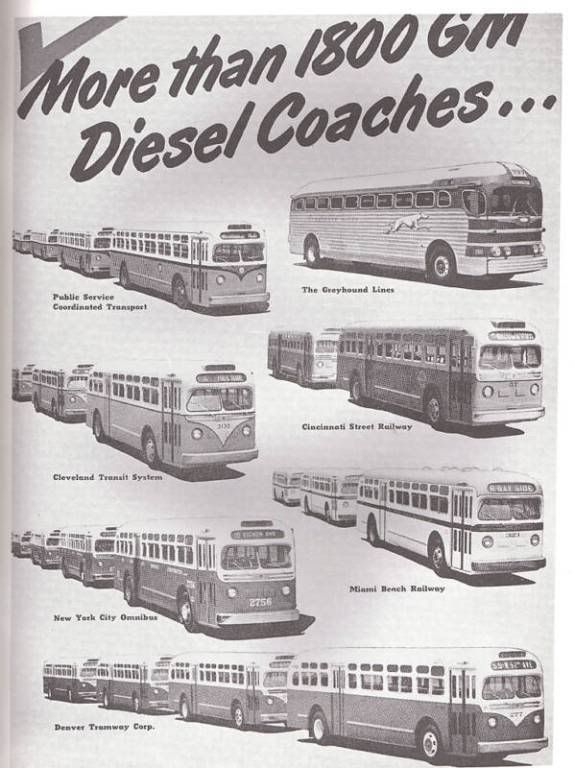 |
|
| Back to top |
|
 |
HwyHaulier
Joined: 16 Dec 2007
Posts: 932
Location: Harford County, MD
|
 Posted: Sat Jun 26, 2010 1:58 pm Post subject: Posted: Sat Jun 26, 2010 1:58 pm Post subject: |
 |
|
Mr 'L' -
That's an early 1950s photo, no doubt...
GREYHOUND... GM continued with a view of a "3751" type. Never mind the "4103" may have been on the drawing boards...
PSNJ? What a classy fleet, with the money to back it up! What can I say?
MIAMI? I have reports wherein reliable heating isn't much of a consideration in its fleet purchases? True story? <G>
.................Vern................... |
|
| Back to top |
|
 |
Mr. Linsky
BusTalk's Offical Welcoming Committee

Joined: 16 Apr 2007
Posts: 5071
Location: BRENTWOOD, CA. - WOODMERE, N.Y.
|
 Posted: Sat Jun 26, 2010 2:21 pm Post subject: Posted: Sat Jun 26, 2010 2:21 pm Post subject: |
 |
|
H.H.,
I was wondering how the 'Silversides' made the photo but I guess it was just about the end of the line for it.
According to 'Bus World' (Encyclopedia of Buses), the last production year of both the PD 3751 and PD 4151 for Greyhound was 1948.
Public Service Coordinated Transport of New Jersey always had beautiful equipment and, if you'll notice, they used their own custom made cast aluminum logo and wings under the windshields.
Regards,
Mr. 'L' |
|
| Back to top |
|
 |
yc720_06
Age: 86
Joined: 18 Apr 2010
Posts: 19
Location: Glasgow, Scotland, UK
|
 Posted: Tue Aug 17, 2010 6:28 pm Post subject: New York Railways Company transit bus Posted: Tue Aug 17, 2010 6:28 pm Post subject: New York Railways Company transit bus |
 |
|
| This is a tad late I know Mr "L" but I thought you might like to know that the New York Railways Company transit bus was a front wheel drive Uppercu, built by the Healey-Aeromarine Bus Company of Keyport, New Jersey. A front wheel drive double decker prototype was also built at Nutley NJ in 1924 and was featured in a brochure for an unsuccessful New York City franchise proposal by the Service Bus Corporation. |
|
| Back to top |
|
 |
Mr. Linsky
BusTalk's Offical Welcoming Committee

Joined: 16 Apr 2007
Posts: 5071
Location: BRENTWOOD, CA. - WOODMERE, N.Y.
|
 Posted: Wed Aug 18, 2010 1:05 am Post subject: Posted: Wed Aug 18, 2010 1:05 am Post subject: |
 |
|
yc,
It's never too late to add information that will make the story more complete.
Thanks for the info.
Have placed another copy of the picture for reference.
That must have been some tough ride with those wheels!
Regards,
Mr. 'L'
 |
|
| Back to top |
|
 |
Mr. Linsky
BusTalk's Offical Welcoming Committee

Joined: 16 Apr 2007
Posts: 5071
Location: BRENTWOOD, CA. - WOODMERE, N.Y.
|
 Posted: Sat Aug 28, 2010 12:50 am Post subject: Posted: Sat Aug 28, 2010 12:50 am Post subject: |
 |
|
I thought I saw everything until I saw the attached ad from 1936 on eBay.
I'm wondering if this was the same Gar Wood that made the rubbish collection bodies?
If it was, I can understand why they changed there business model because they sure didn't sell a whole lot of these buses!
Enjoy,
Mr. Linsky - Green Bus Lines, Inc., Jamaica, New York
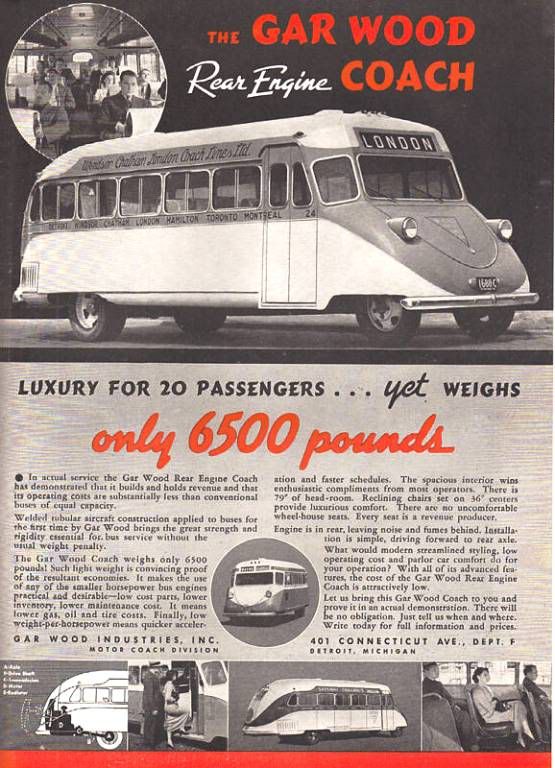 |
|
| Back to top |
|
 |
HwyHaulier
Joined: 16 Dec 2007
Posts: 932
Location: Harford County, MD
|
 Posted: Sun Aug 29, 2010 8:22 am Post subject: Posted: Sun Aug 29, 2010 8:22 am Post subject: |
 |
|
Mr 'L' -
GAR WOOD discussed here: http://www.coachbuilt.com/bui/g/gar_wood/gar_wood.htm
At best, something of an incidental builder. When Randy had the his "Strayhound" site running, it had some
photos at a few Michigan points, where the Greyhound operator had some Gar Wood coaches in service.
.................Vern................ |
|
| Back to top |
|
 |
|
|
You cannot post new topics in this forum
You cannot reply to topics in this forum
You cannot edit your posts in this forum
You cannot delete your posts in this forum
You cannot vote in polls in this forum
You can attach files in this forum
You can download files in this forum
|
Powered by phpBB © 2001, 2005 phpBB Group
|
















